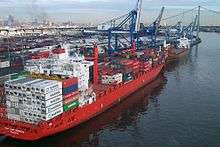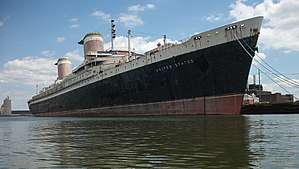Port of Philadelphia
| Port of Philadelphia | |
|---|---|
 | |
| Location | |
| Country | United States |
| Location | Philadelphia |
| Details | |
| Operated by | Philadelphia Regional Port Authority |
| Owned by | Pennsylvania |
| Statistics | |
| Draft depth | 40 feet |
| Air draft | 188 feet, restricted by Delaware Memorial Bridge |
|
Website philaport.com | |
The Port of Philadelphia sometimes collectively refers to all the public and private ports and marine terminals located along the Pennsylvania and New Jersey sides of the Delaware River in the Philadelphia region. Most often, however, the term applies to the publicly-owned marine terminals located within Philadelphia city limits along the Philadelphia side of the Delaware River. These terminals are managed by the Philadelphia Regional Port Authority, PhilaPort,[1] an agency of the Commonwealth of Pennsylvania.
PhilaPort (The Philadelphia Regional Port Authority)
The Philadelphia Regional Port Authority, commonly known as PhilaPort, and referred to as The Port of Philadelphia, is an independent agency of the Commonwealth of Pennsylvania charged with the management, maintenance, marketing, and promotion of port facilities along the Delaware River in Pennsylvania, as well as strategic planning throughout the port district. PhilaPort works with its terminal operators to improve its facilities and to market those facilities to prospective port users around the world. Port cargoes and the activities they generate are responsible for thousands of direct and indirect jobs in the Philadelphia area and throughout Pennsylvania.
Terminals
The Port consists of a series of marine terminals, each with specialized capabilities.
The Packer Avenue Marine Terminal, the Port’s busiest facility, handles containers, steel, frozen meat, fruit, and automobiles. Tioga Marine Terminal handles regular shipments of pulp cargoes from Brazil and a variety of breakbulk cargoes, including steel. Pier 84 is dedicated exclusively to cocoa beans and cocoa products. Piers 38, 40, 74, 78, and 80 (along with their associated on-dock warehouses comprise the Philadelphia Forest Products Center, which handles newsprint, wood pulp, lumber, coated paper, and other forest products. The Port’s Automobile-Handling Facility in South Philadelphia processes and ships to US car dealerships Hyundai and Kia automobiles that arrive weekly by the thousands at the adjacent Packer Avenue Marine Terminal.
Recent Developments
Delaware River Main Channel Deepening: A project to deepen the Delaware River’s 103-mile main shipping channel from 40 to 45 feet began in 2010 and will be completed in 2017. The $392 million project was funded by the Federal Government and local-match sponsor PhilaPort (using Commonwealth of Pennsylvania general funds).[2]
Port Development Plan: A $300 million Port Development Plan was announced by the Commonwealth in November 2016, which will expand and improve cargo operations throughout the Port’s busiest areas.[3]
New Leadership: In August 2016 PhilaPort's Board of Directors hired Jeff Theobald, a maritime industry professional with more than 40 years of experience in terminal operations and shipping logistics, as its new Executive Director and CEO, to further professionalize the port’s operations.
Infrastructure Upgrade: As part of the $300 million Port Development Plan, the first two of five giant cranes capable of unloading the largest container ships arrived in March 2018 from China, where they were manufactured. [4]
History

The Port of Philadelphia was established more than 300 years ago during the colonial period, and was for a time the busiest port in both that period and the earliest years of the new republic, finally being eclipsed by the Port of New York. In much of the 20th Century, the Port was overseen by the city’s Department of Wharves, Docks, and Ferries, which was replaced by the quasi-public Philadelphia Port Corporation in 1964.
In 1989, following the lead of other municipal ports that made overtures to their respective state governments for capital and operating support, the Port of Philadelphia moved from city to state control, with a new agency, the Philadelphia Regional Port Authority, established by the State Legislature’s Act 50 of 1989 to run the Port. The Port of Philadelphia has always been a landlord port, with private companies being given leases to run the Port’s facilities, with capital and marketing support provided by the Commonwealth and PRPA.[5]
PhilaPort (The Port of Philadelphia)
On May 22, 2017, The Philadelphia Regional Port Authority (PRPA) announced that it was rebranding as PhilaPort (The Port of Philadelphia) effective immediately. The name ‘PhilaPort’ was decided on to distinguish The Port of Philadelphia from the many other regional authorities.[6]
References
- ↑ "Home". Philadelphia Regional Port Authority. Retrieved 2017-01-30.
- ↑ "Main Channel Deepening". Philadelphia Regional Port Authority. Retrieved 2017-01-30.
- ↑ "Port Development Plan". Philadelphia Regional Port Authority. Retrieved 2017-01-30.
- ↑ http://www.philly.com/philly/news/pennsylvania/philadelphia/philaport-china-philadelphia-holt-prpa-crane-20180324.html
- ↑ "History of PRPA". Philadelphia Regional Port Authority. Retrieved 2017-01-30.
- ↑ "It's a Brand New Day at PhilaPort » PRPA Rebrands". PhilaPort. Retrieved 2017-05-31.
External links
- 2016 Philadelphia Regional Port Authority Advertorial
- US Harbors Tides Philadelphia
- Philadelphia Regional Port Authority - Official website
- (Philadelphia Regional Port Authority presentation)
- http://www.philaport.com/facilities/
- http://www.philaport.com/about/history-of-prpa/
Coordinates: 39°55′6.1″N 75°8′11.8″W / 39.918361°N 75.136611°W